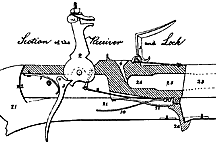
In 1819, John H. Hall, a New England gunmaker, signed a contract with the War Department to produce 1,000 breechloading rifles – a weapon he had designed and patented in 1811. Under the terms of the contract Hall came to Harpers Ferry, where he occupied an old Armory sawmill along the Shenandoah River. The site soon became known as Hall's Rifle Works, and the small island on which it stood was called Lower Hall Island. Hall spent several years tooling new workshops and perfecting precision machinery for producing rifles with interchangeable parts – a boldly ambitious goal for an industry which was traditionally based on the manual labor of skilled craftsmen. In a letter to Secretary of War John Calhoun on December 20, 1822, Hall described his recent accomplishments at Harpers Ferry:
During his two decades at Harpers Ferry, Hall developed and constructed drop-hammers, stock-making machines, balanced pulleys, drilling machines, and special machines for straight-cutting, lever-cutting, and curve-cutting. Hall's straight-cutting machine was the forerunner of today's versatile milling machine, and a critical tool used in the fabrication of precision metal firearm components. Hall's success at Harpers Ferry was attested to by Colonel George Talcott of the Ordnance Department, who wrote in 1832 that Hall's "manufactory has been carried to a greater degree of perfection, as regards the quality of work and uniformity of parts than is to be found anywhere – almost everything is performed by machinery, leaving very little dependent on manual labor." From 1820-1840, John H. Hall devoted his uncompromising attention to the "uniformity principle" of interchangeable manufacture, laying a solid foundation for America's developing factory system right here at Harpers Ferry. Bibliography
|
Last updated: September 23, 2019
